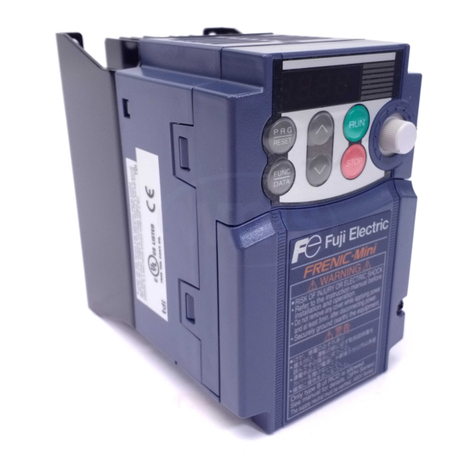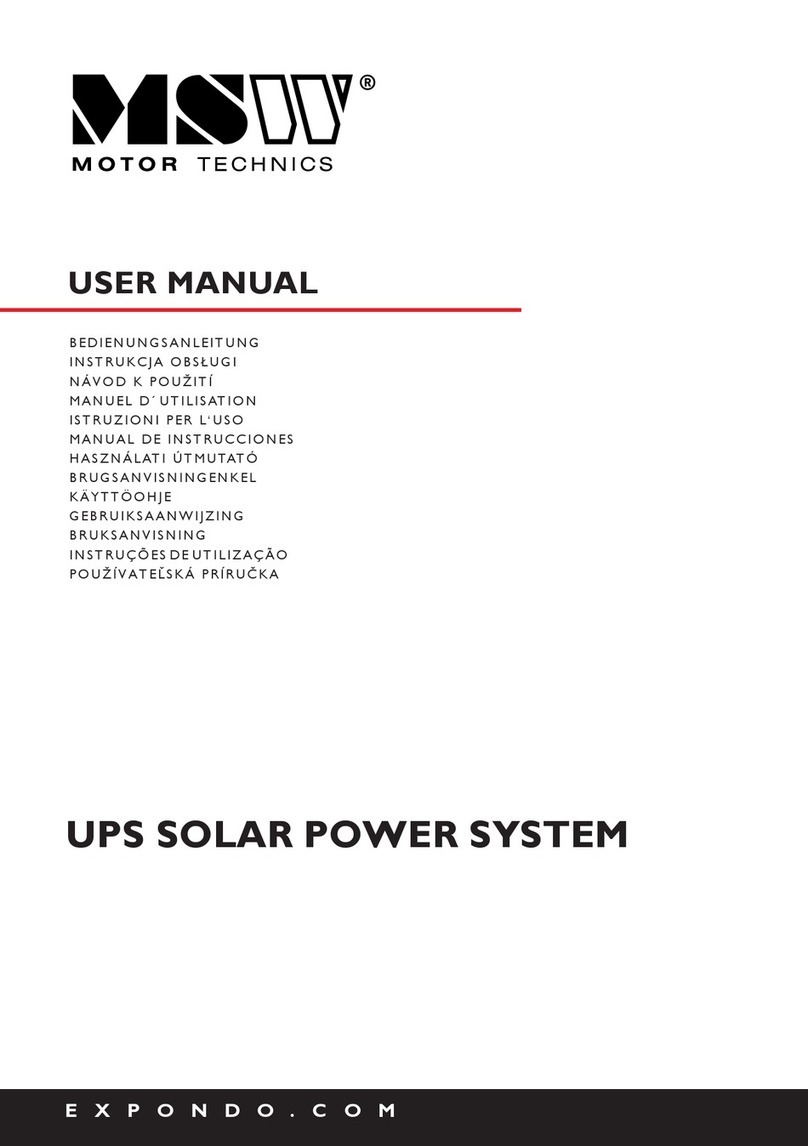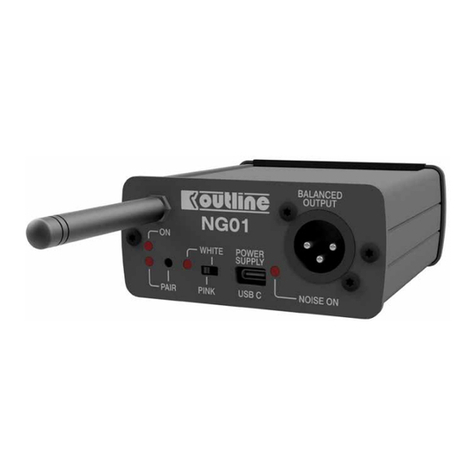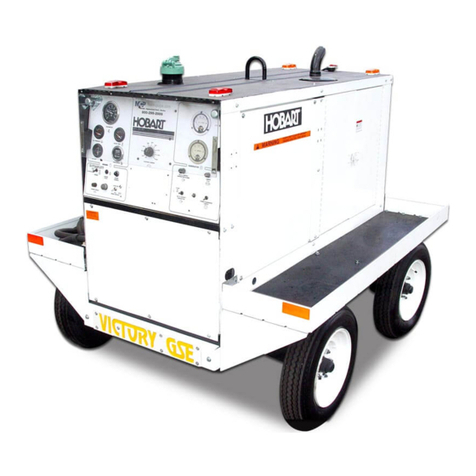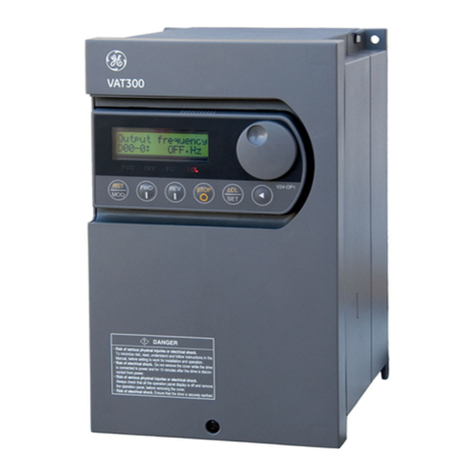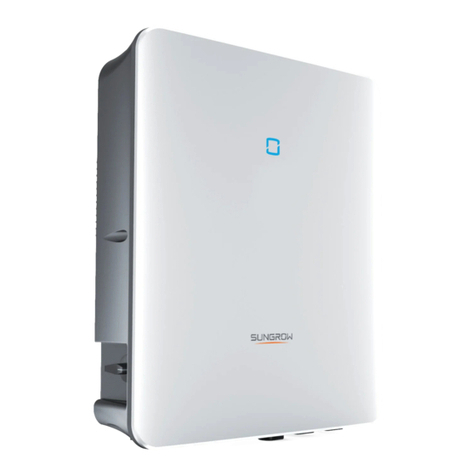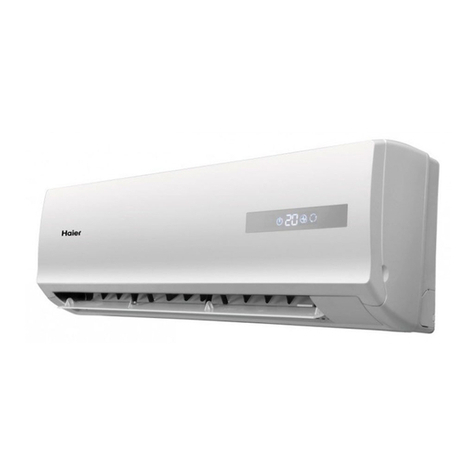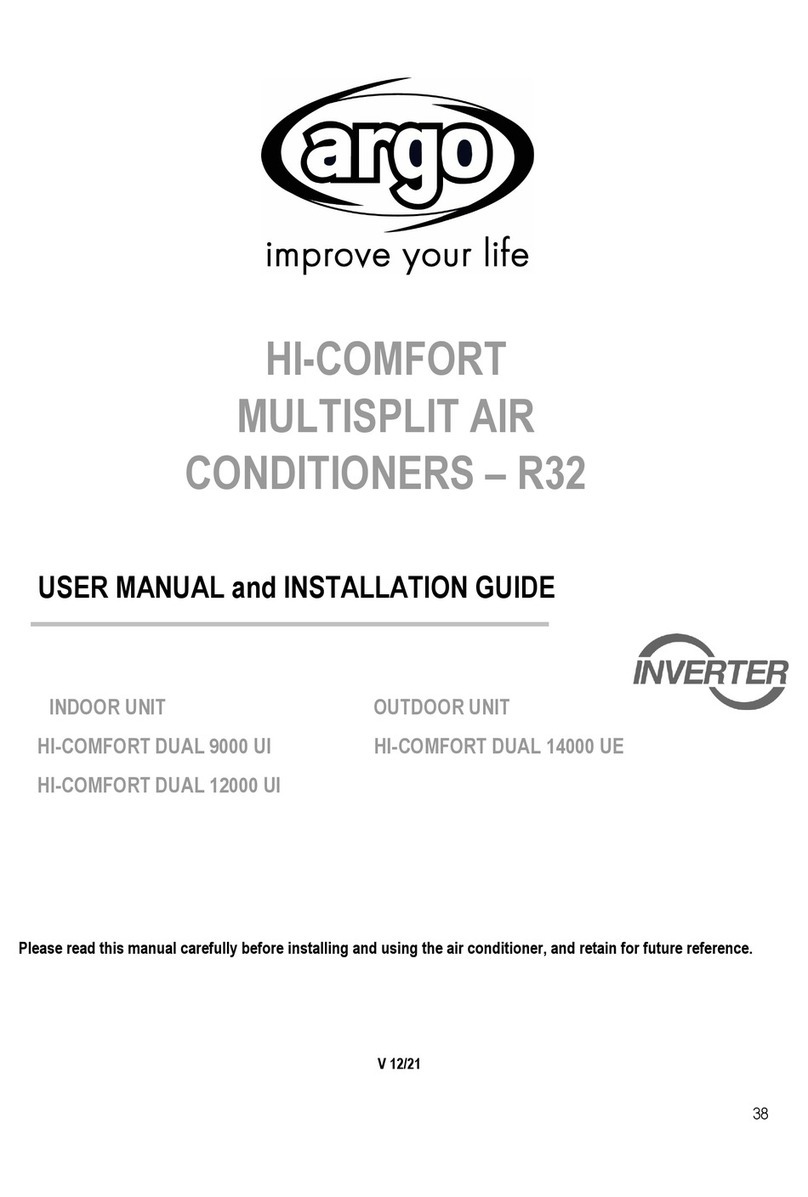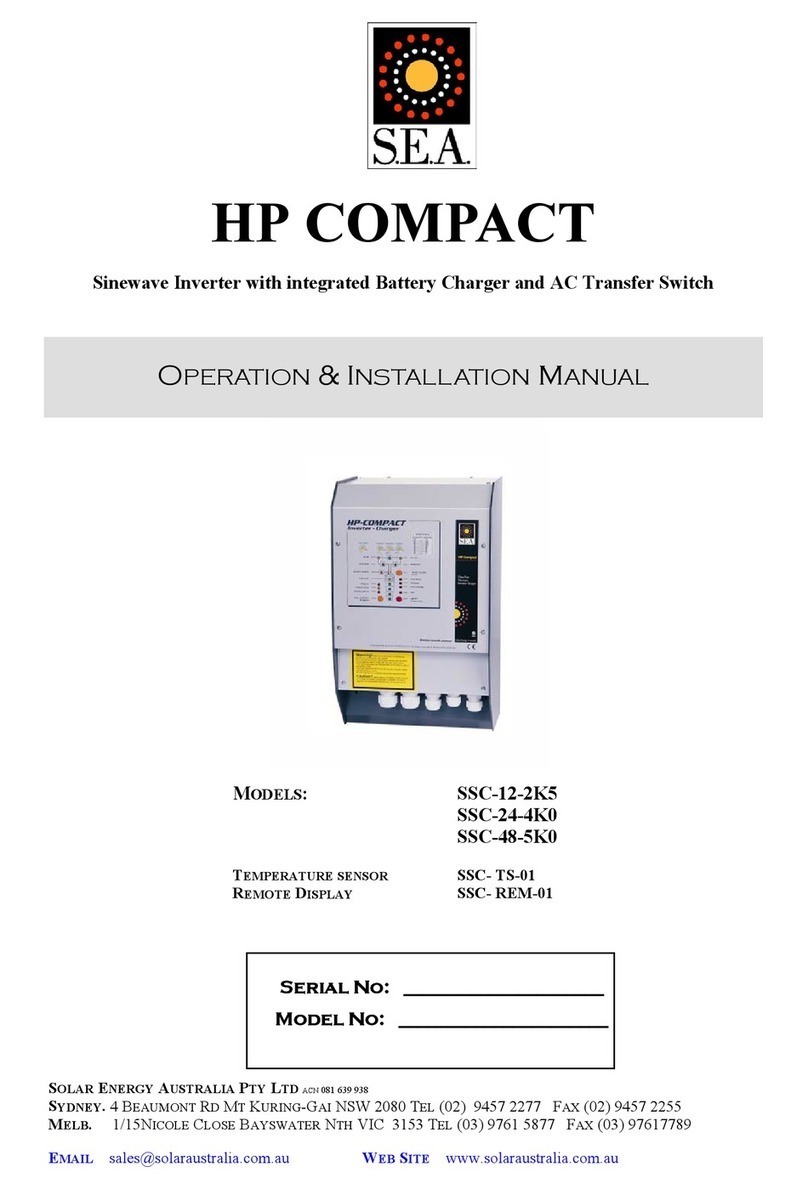FE FRENIC-Multi series User manual

Instruction Manual
High Performance Compact Inverter
Thank you for purchasing our FRENIC-Multi series of inverters.
• This product is designed to drive a three-phase induction otor. Read through this instruction
anual and be fa iliar with the handling procedure for correct use.
• I proper handling ight result in incorrect operation, a short life, or even a failure of this
product as well as the otor.
• Deliver this anual to the end user of this product. Keep this anual in a safe place until this
product is discarded.
• For how to use an optional device, refer to the instruction and installation anuals for that
optional device.
Fuji Electric FA Components & Systems Co. Ltd. INR-SI47-1094-E

Copyright © 2006 Fuji Electric FA Components & Systems Co., Ltd.
All rights reser ed.
No part of this publication may be reproduced or copied without prior written permission from Fuji
Electric FA Components & Systems Co., Ltd.
All products and company names mentioned in this manual are trademarks or registered trademarks
of their respecti e holders.
The information contained herein is subject to change without prior notice for impro ement.

i
Preface
Thank you for purchasing our FRENIC-Multi series of inverters.
This product is designed to drive a three-phase inductionmotor for fan and pump applications. Read
through this instruction manual and be familiar with proper handling and operation of this product.
Improper handling might result in incorrect operation, a short life, or even a failure of this product as
well as the motor.
Have this manual delivered to the end user of this product. Keep this manual in a safe place until this
product is discarded.
Listed below are the other materials related to the use of the FRENIC-Multi. Read them in
conjunction with this manual as necessary.
• FRENIC-Multi User's Manual (MEH457)
• RS-485 Communication User's Manual (MEH448b)
The materials are subject to change without notice. Be sure to obtain the latest editions for use.
Safety precautions
Read this manual thoroughly before proceeding with installation, connections (wiring), operation, or
maintenance and inspection. Ensure you have sound knowledge of the device and familiarize
yourself with all safety information and precautions before proceeding to operate the inverter.
Safety precautions are classified into the following two categories in this manual.
Failure to heed the information indicated by this symbol may
lead to dangerous conditions, possibly resulting in death or
serious bodily injuries.
Failure to heed the information indicated by this symbol may
lead to dangerous conditions, possibly resulting in minor or
light bodily injuries and/or substantial property damage.
Failure to heed the information contained under the CAUTION title can also result in serious
consequences. These safety precautions are of utmost importance and must be observed at all
times.
Application
• FRENIC-Multi is designed to drive a three-phase induction motor. Do not use it for
single-phase motors or for other purposes.
Fire or an accident could occur.
• FRENIC-Multi may not be used for a life-support system or other purposes directly related
to the human safety.
• Though FRENIC-Multi is manufactured under strict quality control, install safety devices
for applications where serious accidents or material losses are foreseen in relation to the
failure of it.
An accident could occur.

ii
Installation
• Install the inverter on a nonflammable material such as metal.
Otherwise fire could occur.
• Do not place flammable object nearby.
Doing so could cause fire.
• Do not support the inverter by its terminal block cover during transportation.
Doing so could cause a drop of the inverter and injuries.
• Prevent lint, paper fibers, sawdust, dust, metallic chips, or other foreign materials from
getting into the inverter or from accumulating on the heat sink.
Otherwise, a fire or an accident might result.
• Do not install or operate an inverter that is damaged or lacking parts.
Doing so could cause fire, an accident or injuries.
• Do not get on a shipping box.
• Do not stack shipping boxes higher than the indicated information printed on those boxes.
Doing so could cause injuries.
Wiring
• When wiring the inverter to the power supply, insert a recommended molded case circuit
breaker (MCCB) or residual-current-operated protective device (RCD)/earth leakage
circuit breaker (ELCB) (with overcurrent protection) in the path of power lines. Use the
devices within the recommended current range.
• Use wires in the specified size.
• When wiring the inverter to the power supply that is 500 kVA or more, be sure to connect
an optional DC reactor (DCR).
Otherwise, fire could occur.
• Do not use one multicore cable in order to connect several inverters with motors.
• Do not connect a surge killer to the inverter's output (secondary) circuit.
Doing so could cause fire.
• Ground the inverter in compliance with the national or local electric code.
Otherwise, electric shock could occur.
• Qualified electricians should carry out wiring.
• Be sure to perform wiring after turning the power OFF.
Otherwise, electric shock could occur.
• Be sure to perform wiring after installing the inverter body.
Otherwise, electric shock or injuries could occur.

iii
• Ensure that the number of input phases and the rated voltage of the product match the
number of phases and the voltage of the AC power supply to which the product is to be
connected.
Otherwise fire or an accident could occur.
• Do not connect the power supply wires to output terminals (U, V, and W).
• Do not insert a braking resistor between terminals P (+) and N (-), P1 and N (-), P (+) and
P1, DB and N (-), or P1 and DB.
Doing so could cause fire or an accident.
• Generally, control signal wires are not reinforced insulation. If they accidentally touch any
of live parts in the main circuit, their insulation coat may break for any reasons. In such a
case, an extremely high voltage may be applied to the signal lines. Make a complete
remedy to protect the signal line from contacting any hot high voltage lines.
Doing so could cause an accident or electric shock.
• Wire the three-phase motor to terminals U, V, and W of the inverter, aligning phases each
other.
Otherwise injuries could occur.
• The inverter, motor and wiring generate electric noise. Take care of malfunction of the
nearby sensors and devices. To prevent the motor from malfunctioning, implement noise
control measures.
Otherwise an accident could occur.
Operation
• Be sure to install the terminal cover before turning the power ON. Do not remove the
covers while power is applied.
Otherwise electric shock could occur.
• Do not operate switches with wet hands.
Doing so could cause electric shock.
• If the auto-reset function has been selected, the inverter may automatically restart and
drive the motor depending on the cause of tripping.
(Design the machinery or equipment so that human safety is ensured after restarting.)
• If the stall prevention function (current limiter), automatic deceleration, and overload
prevention control have been selected, the inverter may operate at an
acceleration/deceleration time or frequency different from the commanded ones. Design
the machine so that safety is ensured even in such cases.
Otherwise an accident could occur.

iv
• The key on the keypad is effective only when the keypad operation is enabled with
function code F02 (= 0, 2 or 3). When the keypad operation is disabled, prepare an
emergency stop switch separately for safe operations.
Switching the runcommand sourcefrom keypad (local) toexternal equipment (remote) by
turning ON the "Enable communications link" command LE disables the key. To
enable the key foran emergency stop, select the STOP key priority with function code
H96 (= 1 or 3).
• If an alarm reset is made with the Run command signal turned ON, a sudden start will
occur. Ensure that the Run command signal is turned OFF in advance.
Otherwise an accident could occur.
• If you enable the "Restart mode after momentary power failure" (Function code F14 = 4 or
5), then the inverter automatically restarts running the motor when the power is recovered.
(Design the machinery or equipment so that human safety is ensured after restarting.)
• If you set the function codes wrongly or without completely understanding this instruction
manual and the FRENIC-Multi User's Manual (MEH457), the motor may rotate with a
torque or at a speed not permitted for the machine.
An accident or injuries could occur.
• Do not touch the inverter terminals while the power is applied to the inverter even if the
inverter stops.
Doing so could cause electric shock.
• Do not turn the main circuit power (circuit breaker) ON or OFF in order to start or stop
inverter operation.
Doing so could cause failure.
• Do not touch the heat sink and braking resistor because they become very hot.
Doing so could cause burns.
• Setting the inverter to highspeeds is easy. Before changingthefrequency(speed) setting,
check the specifications of the motor and machinery.
• The brake function of the inverter does not provide mechanical holding means.
Injuries could occur.

v
Maintenance and inspection, and parts replacement
• Turn the power OFF and wait for at least five minutes before starting inspection. Further,
check that the LED monitor is unlit and that the DC link bus voltage between the P(+) and
N (-) terminals is lower than 25 VDC.
Otherwise, electric shock could occur.
• Maintenance, inspection, and parts replacement should be made only by qualified
persons.
• Take off the watch, rings and other metallic objects before starting work.
• Use insulated tools.
Otherwise, electric shock or injuries could occur.
Disposal
• Treat the inverter as an industrial waste when disposing of it.
Otherwise injuries could occur.
Others
• Never attempt to modify the inverter.
Doing so could cause electric shock or injuries.
GENERAL PRECAUTIONS
Drawings in this manual may be illustrated without covers or safetyshields for explanation of
detail parts. Restore the covers and shields in the original state and observe the description
in the manual before starting operation.

vi
Precautions for use
Driving a 400 V
general-purpose
motor
When driving a 400V general-purpose motor with an inverter
using extremely long wires, damage to the insulation of the
motor may occur. Use an output circuit filter (OFL) if
necessary after checking with the motor manufacturer. Fuji
motors do not require the use of output circuit filters because
of their reinforced insulation.
Torque
characteristics
and temperature
rise
When the inverter is used to run a general-purpose motor,
the temperature of the motor becomes higher than when it is
operated using a commercial power supply. In the low-speed
range, the cooling effect will be weakened, so decrease the
output torque of the motor.
Vibration
When an inverter-driven motor is mounted to a machine,
resonance may be caused by the natural frequencies of the
machine system.
Note that operation of a 2-pole motor at 60 Hz or higher may
cause abnormal vibration.
* The use of a rubber coupling or vibration-proof rubber is
recommended.
* Use the inverter's jump frequency control feature to skip
the resonance frequency zone(s).
In running
general-
purpose
motors
Noise
When an inverter is used with a general-purpose motor, the
motor noise level is higher than that with a commercial power
supply. To reduce noise, raise carrier frequency of the
inverter. Operation at 60 Hz or higher can also result in
higher noise level.
High-speed
motors If the reference frequency is set to 120 Hz or more to drive a
high-speed motor, test-run the combination of the inverter
and motor beforehand to check for safe operation.
Explosion-proof
motors When driving an explosion-proof motor with an inverter, use
a combination of a motor and an inverter that has been
approved in advance.
Submersible
motors and
pumps
These motors have a larger rated current than
general-purpose motors. Select an inverter whose rated
output current is greater than that of the motor.
These motors differ from general-purpose motors in thermal
characteristics. Set a low value in the thermal time constant
of the motor when setting the electronic thermal function.
Brake motors
For motors equipped with parallel-connected brakes, their
power supply for brake must be supplied from the primary
circuit. If the power supply for brake is connected to the
inverter's output circuit by mistake, the brake will not work.
Do not use inverters for driving motors equipped with
series-connected brakes.
In running
special
motors
Geared motors If the power transmission mechanism uses an oil-lubricated
gearbox or speed changer/reducer, then continuous
operation at low speed may cause poor lubrication. Avoid
such operation.

vii
Synchronous
motors It is necessary to take special measures suitable for this
motor type. Contact your Fuji Electric representative for
details.
In running
special
motors Single-phase
motors
Single-phase motors are not suitable for inverter-driven
variable speed operation. Use three-phase motors.
Even if a single-phase power supply is available, use a
three-phase motor as the inverter provides three-phase
output.
Environ-
mental
conditions
Installation
location
Use the inverter within the ambient temperature range from
-10 to +50°C.
The heat sink and braking resistor of the inverter may
become hot under certain operating conditions, so install the
inverter on nonflammable material such as metal.
Ensure that the installation location meets the environmental
conditions specified in Chapter 2, Section 2.1 "Operating
Environment."
Installing an
MCCB or
RCD/ELCB
Install a recommended molded case circuit breaker (MCCB)
or residual-current-operated protective device (RCD)/earth
leakage circuit breaker (ELCB) (with overcurrent protection)
in the primary circuit of the inverter to protect the wiring.
Ensure that the circuit breaker rated current is equivalent to
or lower than the recommended rated current.
Installing an MC
in the secondary
circuit
If a magnetic contactor (MC) is mounted in the inverter's
output (secondary) circuit for switching the motor to
commercial power or for any other purpose, ensure that both
the inverter and the motor are completely stopped before you
turn the MC ON or OFF.
Remove the magnet contactor (MC) already installed and
built-in surge killer from the inverter's output (secondary)
circuit before installing the MC to switch the motor power.
Installing an MC
in the primary
circuit
Do not turn the magnetic contactor (MC) inthe primarycircuit
ON or OFF more than once an hour as an inverter failure
may result.
If frequent starts or stops are required during motor
operation, use terminal [FWD]/[REV] signals or the
RUN/STOP key.
Combina-
tion with
peripheral
devices
Protecting the
motor
The electronic thermal function of the inverter can protect the
motor. The operation level and the motor type
(general-purpose motor, inverter motor) should be set. For
high-speed motors or water-cooled motors, set a small value
for the thermal time constant and protect the motor.
If you connect the motor thermal relay to the motor with a
long wire, a high-frequency current may flow into the wiring
stray capacitance. This may cause the relay to trip at a
current lower than the set value for the thermal relay. If this
happens, lower the carrier frequency or use the output circuit
filter (OFL).

viii
Discontinuance
of power
capacitor for
power factor
correction
Do not mount power capacitors for power factor correction in
the inverter’s primary circuit. (Use the DC reactor to correct
the inverter power factor.) Do not use power capacitors for
power factor correction in the inverter’s output (secondary)
circuit. An overcurrent trip will occur, disabling motor
operation.
Discontinuance
of surge killer Do not connect a surge killer to the inverter's output
(secondary) circuit.
Reducing noise Use of a filter and shielded wires is typically recommendedto
satisfy EMC Directive.
Measures against
surge currents
If an overvoltage trip occurs while the inverter is stopped or
operated under a light load, it is assumed that the surge
current is generated by open/close of the power capacitor for
power factor correction in the power system.
* Connect a DC reactor to the inverter.
Combina-
tion with
peripheral
devices
Megger test When checking the insulation resistance of the inverter, use
a 500 V megger and follow the instructions contained in
Chapter 7, Section 7.5 "Insulation Test."
Control circuit
wiring length
When using remote control, limit the wiring length between
the inverter and operator panel to 20 m or less and use
twisted pair or shielded wire.
Wiring length
between inverter
and motor
If long wiring is used between the inverter and the motor, the
inverter will overheat or trip as a result of overcurrent
(high-frequency current flowing into the stray capacitance) in
the wires connected to the phases. Ensure that the wiring is
shorter than 50 m. If this length must be exceeded, lower the
carrier frequency or mount an output circuit filter (OFL).
Wiring size Select wires with a sufficient capacity by referring to the
current value or recommended wire size.
Wiring type When several inverters drive motors, do not use one
multicore cable in order to connect several inverters with
motors.
Wiring
Grounding Securely ground the inverter using the grounding terminal.
Driving
general-purpose
motor
Select an inverter according to the nominal applied motor
rating listed in the standard specifications table for the
inverter.
When high starting torque is required or quick acceleration or
deceleration is required, select an inverter with one rank
larger capacity than the standard.
Selecting
inverter
capacity
Driving special
motors Select an inverter that meets the following condition:
Inverter rated current > Motor rated current
Transpor-
tation and
storage
When transporting or storing inverters, follow the procedures and select locations
that meet the environmental conditions listed in Chapter 1, Section 1.3
"Transportation" and Section 1.4 "Storage Environment."

ix
How this manual is organized
This manual is made up of chapters 1 through 9.
Chapter 1 BEFORE USING THE INVERTER
This chapter describes acceptance inspection and precautions for transportation and storage of the
inverter.
Chapter 2 MOUNTING AND WIRING OF THE INVERTER
This chapter provides operating environment, precautions for installing the inverter, wiring
instructions for the motor and inverter.
Chapter 3 OPERATION USING THE KEYPAD
This chapter describes inverter operation using the keypad. The inverter features three operation
modes (Running, Programming and Alarm modes) which enable you to run and stop the motor,
monitor running status, set function code data, display running information required for maintenance,
and display alarm data.
Chapter 4 RUNNING THE MOTOR
This chapter describes preparation to be made before running the motor for a test and practical
operation.
Chapter 5 FUNCTION CODES
This chapter provides a list of the function codes. Function codes to be used often and irregular ones
are described individually.
Chapter 6 TROUBLESHOOTING
This chapter describes troubleshooting procedures to be followed when the inverter malfunctions or
detects an alarm condition. In this chapter, first check whether any alarm code is displayed or not,
and then proceed to the troubleshooting items.
Chapter 7 MAINTENANCE AND INSPECTION
This chapter describes inspection, measurement and insulation test which are required for safe
inverter operation. It also provides information about periodical replacement parts and guarantee of
the product.
Chapter 8 SPECIFICATIONS
This chapter lists specifications including output ratings, control system, external dimensions and
protective functions.
Chapter 9 LIST OF PERIPHERAL EQUIPMENT AND OPTIONS
This chapter describes main peripheral equipment and options which can be connected to the
FRENIC-Multi series of inverters.
Icons
The following icons are used throughout this manual.
This icon indicates information which, if not heeded, can result in the inverter not operating
to full efficiency, as well as information concerning incorrect operations and settings which
can result in accidents.
This icon indicates information that can prove handy when performing certain settings o
r
operations.
This icon indicates a reference to more detailed information.

x
Table of Content
Preface ............................................................i
Safety precautions..................................................i
Precautions for use ..............................................vi
How this manual is organized..................................ix
Chapter 1 BEFORE USING THE INVERTER..... 1-1
1.1 Acceptance Inspection............................... 1-1
1.2 External View and Terminal Blocks............ 1-2
1.3 Transportation............................................ 1-3
1.4 Storage Environment................................. 1-3
1.4.1 Temporary storage............................ 1-3
1.4.2 Long-term storage............................. 1-3
Chapter 2 MOUNTING AND WIRING OF
THE INVERTER................................. 2-1
2.1 Operating Environment.............................. 2-1
2.2 Installing the Inverter.................................. 2-1
2.3 Wiring......................................................... 2-4
2.3.1 Removing the terminal cover and the
main circuit terminal block cover....... 2-4
2.3.2 Terminal arrangement diagram and
screw specifications.......................... 2-7
2.3.3 Recommended wire sizes................. 2-9
2.3.4 Wiring precautions .......................... 2-10
2.3.5 Wiring for main circuit terminals
and grounding terminals.................. 2-10
2.3.6 Wiring for control circuit terminals... 2-15
2.3.7 Setting up the slide switches........... 2-22
2.4 Mounting and Connecting a Keypad........ 2-24
2.4.1 Mounting style and parts needed
for connection.................................. 2-24
2.4.2 Mounting/installing steps................. 2-25
2.5 Cautions Relating to Harmonic Component,
Noise, and Leakage Current.................... 2-27
Chapter 3 OPERATION USING THE KEYPAD... 3-1
3.1 LED Monitor, Keys and LED Indicators
on the Keypad............................................ 3-1
3.2 Overview of Operation Modes ................... 3-2
3.3 Running Mode ........................................... 3-4
3.3.1 Monitoring the running status............ 3-4
3.3.2 Setting up frequency and PID
commands......................................... 3-6
3.3.3 Running/stopping the motor.............3-11
3.4 Programming Mode..................................3-11
3.4.1 Setting up basic function codes quickly
-- Menu #0 "Quick Setup" -- ............ 3-13
3.4.2 Setting up function codes
-- Menu #1 "Data Setting" --............ 3-15
3.4.3 Checking changed function codes
-- Menu #2 "Data Checking" -- ........ 3-16
3.4.4 Monitoring the running status
-- Menu #3 "Drive Monitoring" --...... 3-16
3.4.5 Checking I/O signal status
-- Menu #4 "I/O Checking" --........... 3-19
3.4.6 Reading maintenance information
-- Menu #5 "Maintenance Information" --
................................................... 3-23
3.4.7 Reading alarm information
-- Menu #6 "Alarm Information" --.... 3-25
3.5 Alarm Mode ............................................. 3-27
Chapter 4..........RUNNING THE MOTOR...........................................................................................4
-
4.1 Running the Motor for a Test......................4-1
4.1.1 Inspection and preparation prior to
powering on.......................................4-1
4.1.2 Turning ON power and checking .......4-1
4.1.3 Preparation before running the motor
for a test--Setting function code data.4-2
<Tuning procedure>................................4-2
Errors during tuning................................4-4
4.1.4 Test run..............................................4-4
4.2 Operation....................................................4-5
4.2.1 Jogging Operation .............................4-5
Chapter 5 FUNCTION CODES............................5-1
5.1 Function Code Tables.................................5-1
5.2 Overview of Function Codes ....................5-13
Chapter 6 TROUBLESHOOTING........................6-1
6.1 Before Proceeding with Troubleshooting....6-1
6.2 If No Alarm Code Appears on the LED
Monitor.......................................................6-2
6.2.1 Motor is running abnormally ..............6-2
6.2.2 Problems with inverter settings..........6-8
6.3 If an Alarm Code Appears on the LED
Monitor.....................................................6-10
6.4 If an Abnormal PatternAppears on the LED
Monitor while No Alarm Code is Displayed
...........................................................6-24
Chapter 7 MAINTENANCE AND INSPECTION...7-1
7.1 Daily Inspection..........................................7-1
7.2 Periodic Inspection.....................................7-1
7.3 List of Periodical Replacement Parts..........7-3
7.3.1 Judgment on service life....................7-4
7.4 Measurement of ElectricalAmounts
in Main Circuit.............................................7-6
7.5 Insulation Test ............................................7-8
7.6 Inquiries about Product and Guarantee......7-9
Chapter 8 SPECIFICATIONS..............................8-1
8.1 Standard Models ........................................8-1
8.1.1 Three-phase 200 V class series........8-1
8.1.2 Three-phase 400 V class series........8-2
8.1.3 Single-phase 200 V class series........8-3
8.2 Specifications of Keypad Related...............8-4
8.2.1 General specifications of keypad.......8-4
8.2.2 Communications specifications of
keypad...............................................8-4
8.3 Terminal Specifications...............................8-5
8.3.1 Terminal functions..............................8-5
8.3.2 Running the inverter with keypad.......8-5
8.3.3 Running the inverter by terminal
commands.........................................8-6
8.4 External Dimensions ..................................8-7
8.4.1 Standard models................................8-7
8.4.2 Standard keypad..............................8-10
8.5 Protective Functions.................................8-11
Chapter 9 LIST OF PERIPHERAL EQUIPMENT
AND OPTIONS...................................9-1

1-1
Chapter 1 BEFORE USING THE INVERTER
1.1 Acceptance Inspection
Unpack the package and check the following:
(1) An inverter and accessories below are contained in the package.
• Cooling fan fixing screws (for inverters of 5.5 to 15 kW)
• Keypad rear cover (with fixing screws)
• Instruction manual (this manual)
(2) The inverter has not been damaged during transportation—there should be no dents or parts
missing.
(3) The inverter is the model you ordered. You can check the model name and specifications on the
main nameplate. (Main and sub nameplates are attached to the inverter and are located as
shown on the following page.)
(a) Main Nameplate (b) Sub Nameplate
Figure 1.1 Nameplates
TYPE: Type of inverter
SOURCE: Number of input phases (three-phase: 3PH, single-phase: 1PH), input voltage, input
frequency, input current
OUTPUT: Number of output phases, rated output capacity, rated output voltage, output frequency
range, rated output current, overload capacity
MASS: Mass of the inverter in kilogram (37 kW or above)
SER. No.: Product number 6 Z 3 7 1 0 K 1 2 0 8
Serial number of production lot
Production month
1 to 9: January to September
X, Y, or Z: October, November, or December
Production year: Last digit of year
If you suspect the product is not working properly or if you have any questions about your product,
contact your Fuji Electric representative.
TYPE
SER.No. FRN5.5E1S-2A
5Z3710K1208
* The nominal applied motor rating o
f
FRN4.0E1S-4E to be shipped to the EU
is 4.0 kW.

1-2
1.2 External View and Terminal Blocks
(1) Outside and inside views
Figure 1.2 Outside and Inside Views of Inverters (FRN15E1S-2)
(2) Warning plates and label
Figure 1.3 Warning Plate and Sub Nameplate
(3) Terminal block location
(a) FRN0.75E1S-2
(b) FRN15E1S-2
Figure 1.4 Terminal Blocks
Note: A box () in the above model names replaces A, C, J, or K depending on the shipping destination.

1-3
1.3 Transportation
• When carrying an inverter, always support its bottom at the right and left sides with both hands. Do
not hold covers or individual parts only.
• Avoid applying excessively strong force to the terminal block covers as they are made of plastic
and are easily broken.
1.4 Storage Environment
1.4.1 Temporary storage
Store the inverter in an environment that satisfies the requirements listed in Table 1.1.
Table 1.1 Environmental Requirements for Storage and Transportation
Item Requirements
Storage temperature *1-25 to +70°C
Relative humidity 5 to 95% *2
A location where the inverter is not subject to abrupt changes
in temperature that would result in the formation of
condensation or ice.
Atmosphere The inverter must not be exposed to dust, direct sunlight, corrosive or
flammable gases, oil mist, vapor, water drops or vibration. The atmosphere
must contain only a low level of salt. (0.01 mg/cm2or less per year)
86 to 106 kPa (in storage)Atmospheric pressure 70 to 106 kPa (during transportation)
*1Assuming a comparatively short storage period (e.g., during transportation or the like).
*2Even if the humidity is within the specified requirements, avoid such places where the inverter will be
subjected to sudden changes in temperature that will cause condensation to form.
Precautions for temporary storage
(1) Do not leave the inverter directly on the floor.
(2) If the environment does not satisfy the specified requirements, wrap the inverter in an airtight
vinyl sheet or the like for storage.
(3) If the inverter is to be stored in an environment with a high level of humidity, put a drying agent
(such as silica gel) in the airtight package described in item (2).
1.4.2 Long-term storage
The long-term storage methods for the inverter vary largely according to the environment of the
storage site. General storage methods are described below.
(1) The storage site must satisfy the requirements specified for temporary storage.
However, for storage exceeding three months, the ambient temperature should be within the
range from -10 to +30 °C. This is to prevent the electrolytic capacitors in the inverter from
deteriorating.
(2) The inverter must be stored in a package that is airtight to protect it from moisture. Include a
drying agent inside the package to maintain the relative humidity inside the package within 70%.
(3) If the inverter has been installed in the equipment or control panel at a construction site where it
may be subjected to humidity, dust or dirt, then remove the inverter and store it in a suitable
environment specified in Table 1.1.
Precautions for storage over 1 year
If the inverter will not be powered on for a long time, the property of the electrolytic capacitors may
deteriorate. Power the inverters on once a year and keep them on for 30 to 60 minutes. Do not
connect the inverter to a motor or run the motor.

2-1
Chapter 2 MOUNTING AND WIRING OF THE INVERTER
2.1 Operating Environment
Install the inverter in an environment that satisfies the requirements listed in Table 2.1.
Table 2.1 Environmental Requirements
Item Specifications
Site location Indoors
Ambient
temperature
-10 to +50°C(Note 1)
Relative
humidity
5 to 95% (No condensation)
Atmosphere The inverter must not be exposed to dust,
direct sunlight, corrosive gases, flammable
gas, oil mist, vapor or water drops. (Note 2)
The atmosphere must contain only a low
level of salt.
(0.01 mg/cm2or less per year)
The inverter must not be subjected to sudden
changes in temperature that will cause
condensation to form.
Altitude 1000 m max. (Note 3)
Atmospheric
pressure
86 to 106 kPa
3 mm (Max. amplitude) 2 to less than 9 Hz
9.8 m/s29 to less than 20 Hz
2 m/s220 to less than 55 Hz
Vibration
1 m/s255 to less than 200 Hz
Table 2.2
Output Current Derating Factor
in Relation to Altitude
Altitude Output current
derating factor
1000 m or lower 1.00
1000 to 1500 m 0.97
1500 to 2000 m 0.95
2000 to 2500 m 0.91
2500 to 3000 m 0.88
(Note 1) When inverters are mounted
side-by-side without any gap between them
(less than 5.5 kW), the ambient temperature
should be within the range from -10 to +40°C.
(Note 2) Do not install the inverter in an
environment where it may be exposed to
cotton waste or moist dust or dirt which will
clog the heat sink in the inverter. If the
inverter is to be used in such an environment,
install it in the panel of your system or othe
r
dustproof containers.
(Note 3) If you use the inverter in an altitude
above 1000 m, you should apply an outpu
t
current derating factor as listed in Table 2.2.
2.2 Installing the Inverter
(1) Mounting base
The temperature of the heat sink will rise up to approx.
90°C during operation of the inverter, so the inverte
r
should be mounted on a base made of material that can
withstand temperatures of this level.
Install the inverter on a base constructed from metal or
other non-flammable material.
A fire may result with other material.
(2) Clearances
Ensure that the minimum clearances indicated in Figure
2.1 are maintained at all times. When installing the inverte
r
in the panel of your system, take extra care with ventilation
inside the panel as the temperature around the inverte
r
will tend to increase. Do not install the inverter in a small e
panel with poor ventilation.
Figure 2.1 Mounting Direction and
Required Clearances

2-2
When mounting two or more inverters
Horizontal layout is recommended when two or more
inverters are to be installed in the same unit or panel. If it is
necessary to mount the inverters vertically, install a partition
plate or the like between the inverters so that any heat
radiating from an inverter will not affect the one/s above. As
long as the ambient temperature is 40°C or lower, inverters
can be mounted side-by-side without any gap between them
(only for inverters with a capacity of less than 5.5 kW).
When employing external cooling
At the shipment time, the inverter is set up for mount inside
your equipment or panel so that cooling is done all internally.
To improve cooling efficiently, you can take the heat sink out
of the equipment or the panel (as shown on the right) so that
cooling is done both internally and externally (this is called
"external cooling").
In external cooling, the heat sink, which dissipates about
70% of the total heat (total loss) generated into air, is situated
outside the equipment or the panel. As a result, much less
heat is radiated inside the equipment or the panel.
To take advantage of external cooling, you need to use the
external cooling attachment option for inverters with a
capacity of 5.5 kW or above.
In an environment with high humidity or a lot of fibrous dust,
however, do not use external cooling in an environment with
high humidity or a lot of fibrous dust, which tends to clog the
heat sink.
For details, refer to the Mounting Adapter for
External Cooling "PB-F1/E1" Installation Manual
(INR-SI47-0880a).
Figure 2.2 External Cooling
Prevent lint, paper fibers, sawdust, dust, metallic chips, or other foreign materials from getting
into the inverter or from accumulating on the heat sink.
This may result in a fire or accident.

2-3
(3) Mounting direction
Mount the inverter vertically to the mounting surface and fix it securely with four screws or bolts so
that the logo "FRENIC-Multi" can be seen from the front.
Do not mount the inverter upside down or horizontally. Doing so will reduce the heat
dissipation efficiency of the inverter and cause the overheat protection function to operate,
so the inverter will not run.
(4) Solving abnormal vibration after installation
If any vibration in the surroundings reaches the inverter and causes abnormal vibration to the cooling
fans or the keypad, fix them firmly using the fixing screws provided as accessories.
Fixing the cooling fans
Table 2.3 Fixing Screws
Power
supply
voltage
Nominal
applied
motor
(kW)
Inverter
type
Screw
size
(accessory)
Tightening
torque
(N·m)
5.5 FRN5.5E1S-2
7.5 FRN7.5E1S-2
11 FRN11E1S-2
Three-
phase
200 V
15 FRN15E1S-2
5.5 FRN5.5E1S-4
7.5 FRN7.5E1S-4
11 FRN11E1S-4
Three-
phase
400 V
15 FRN15E1S-4
M4x35
(4 pcs) 0.8
Note: A box () in the above table replaces A, C, E, J, or K
depending on the shipping destination.
For three-phase 200 V class series of inverters, it replaces
A, C, J, or K.
Figure 2.3 Fixing the Cooling Fans

2-4
2.3 Wiring
Follow the procedure below. (In the following description, the inverter has already been installed.)
2.3.1 Removing the terminal cover and the main circuit terminal block cover
(1) For inverters with a capacity of less than 5.5 kW
To remove the terminal cover, put your finger in the dimple of the terminal cover (labeled
"PULL"), and then pull it up toward you.
To remove the main circuit terminal block cover, hold its right and left ends with your fingers and
slide it toward you.
Figure 2.4 Removing the Covers (For Inverters with a Capacity of Less Than 5.5 kW)

2-5
(2) For inverters with a capacity of 5.5 and 7.5 kW
To remove the terminal cover, first loosen the terminal cover fixing screw on it, and put your
finger in the dimple of the terminal cover (labeled "PULL"), and then pull it up toward you.
To remove the main circuit terminal block cover, put your thumbs on the handles of the main
circuit terminal block cover, and push it up while supporting it with your fingers. (Refer to Figure
2.5.)
Figure 2.5 Removing the Covers (For Inverters with a Capacity of 5.5 and 7.5 kW)
When mounting the main circuit terminal block cover, fit it according to the guide on the
inverter.
Figure 2.6 Mounting the main circuit terminal block cover
(For Inverters with a Capacity of 5.5 and 7.5 kW)
Table of contents
Other FE Inverter manuals
Popular Inverter manuals by other brands
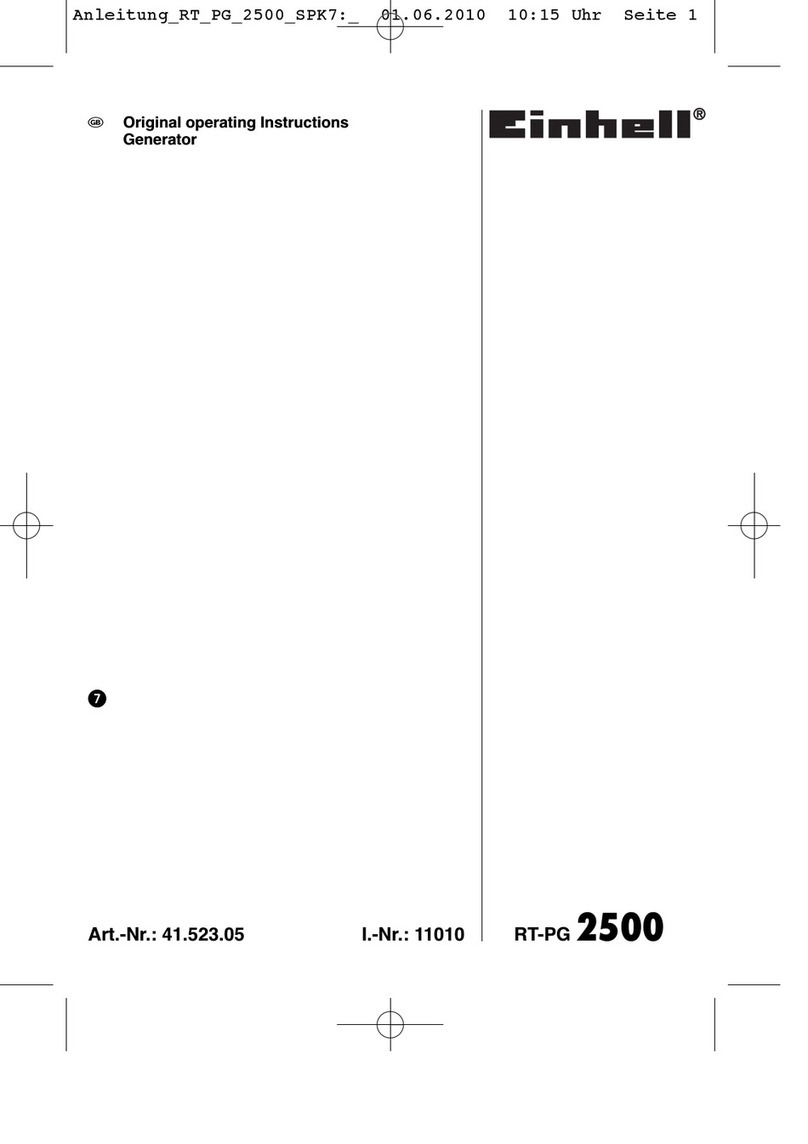
EINHELL
EINHELL RT-PG 2500 Original operating instructions
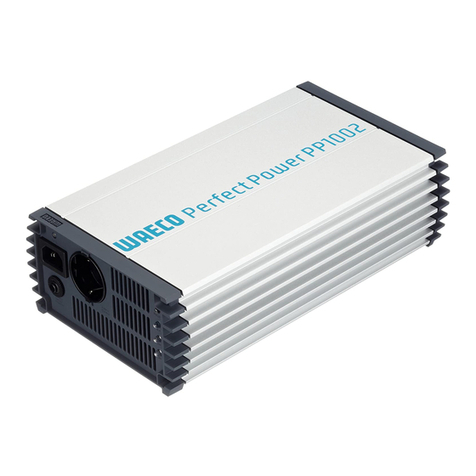
Waeco
Waeco PerfectPower PP1002 Installation and operating manual
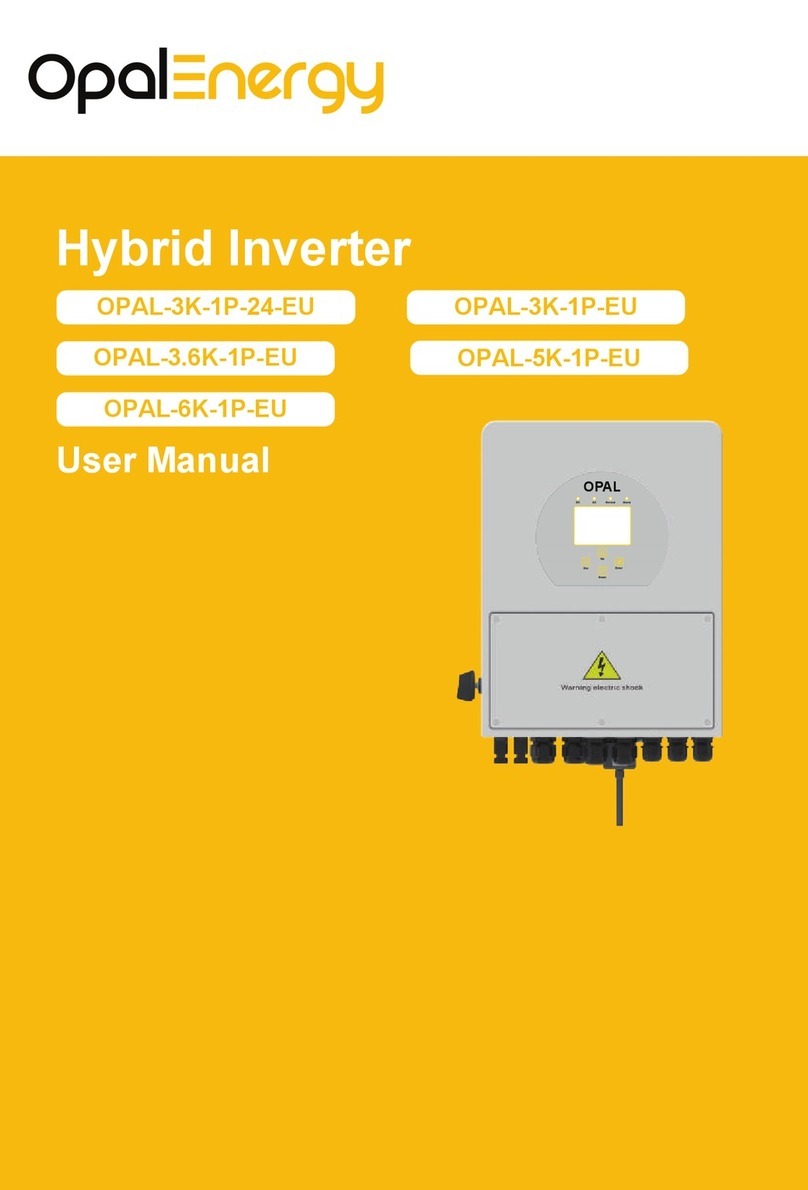
Opal Energy
Opal Energy OPAL-3K-1P-24-EU user manual
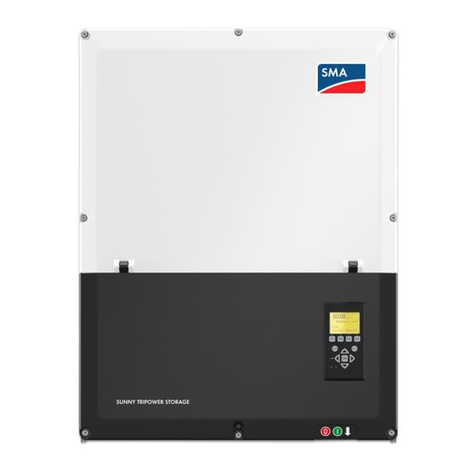
SMA Solar Technology AG
SMA Solar Technology AG STORAGE PACKAGE - BUSINESS System manual
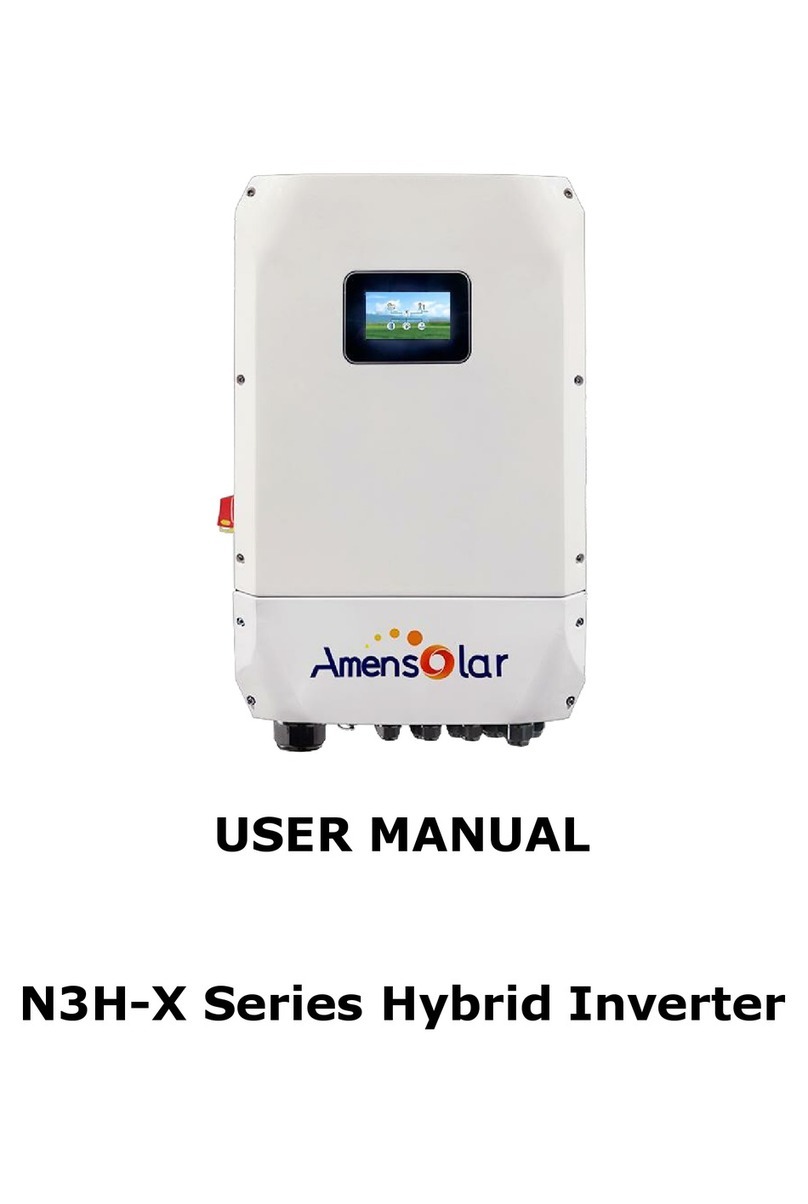
Amensolar
Amensolar N3H-X Series user manual

enphase
enphase IQ8 Quick install guide
